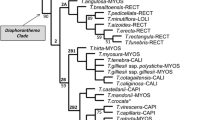Abstract
The evolutionary trend and its ecological implications in sympodial and monopodial branching patterns has been investigated in 20 JapaneseAcer spp. through comparison of shoot tip abortion and terminal bud formation. The genus is divided into two species groups according to its branching pattern, one (6 species) predominantly exhibiting sympodial branching with frequent monopodial branching in short shoots (sympodial species), and the other (14 species) exhibiting only monopodial branching (monopodial species). The early ontogeny of leaf and bud scales is described. Despite the difference in branching patterns, the bud scales of terminal buds are essentially the same in having a leaf base developed to function as a protecting organ. In all the sympodial species, during the abortion of a sympodium shoot tip, one or two pairs of primordia were found to occur on the apex, and later wither. These primordia resemble bud scales of terminal buds in their ontogeny and morphology, and appear to be rudimentary. It is suggested that a rudimentary terminal bud develops together with the establishment of sympodial branching, and that sympodial branching has originated from monopodial branching. Based on this proposed evolutionary trend, it is suggested thatAcer has moved from less shady habitats into shady habitats with monopodial branching (advantageous for vertical growth) changing into sympodial branching (advantageous for lateral spread).
Similar content being viewed by others
References
Addicott, F. T., 1982: Abscission. — Berkeley: University of California Press.
Boojh, R., Ramakrishnan, P. S., 1982: Growth strategy of trees related to successional status. 1. Architecture and extension growth. — Forest Ecol. Manage.4: 359–374.
Garrison, R., Wetmore, R. H., 1961: Studies in shoot-tip abortion:Syringa vulgaris. — Amer. J. Bot.48: 789–795.
King, D., 1981: Tree dimensions: maximizing the rate of height growth in dense stands. — Oecologia51: 351–356.
, 1986: Tree form, height growth, and susceptibility to wind damage inAcer saccharum. — Ecology67: 980–990.
Kohyama, T., 1987: Significance of architecture and allometry in saplings. — Functional Ecology1: 399–404.
Kozlowski, T. T., 1971: Growth and development of trees 1. — New York: Academic Press.
Millington, W. F., 1963: Shoot tip abortion inUlmus americana. — Amer. J. Bot.50: 371–378.
Mueller, R. J., 1988: Shoot tip abortion and sympodial branch reorientation inBrownea ariza (Leguminosae). — Amer. J. Bot.75: 391–400.
Neville, P., 1969: Morphogenese chezGleditsia triacanthos L. 3. Étude histologique et expérimentale de la sénescence des bourgeons. — Ann. Sci. Nat. (Bot.), ser. 12,10: 301–324.
Ogata, K., 1965: A dendrological study on the JapaneseAceraceae, with special reference to the geographical distribution. — Bull. Tokyo Univ. For.60: 1–99.
, 1967: A systematic study of the genusAcer. — Bull. Tokyo Univ. For.63: 89–206.
Sakai, S., 1986: Shoot growth characteristics in JapaneseAcer species and their relationships to regeneration strategies. — Master thesis, University of Tokyo (in Japanese).
, 1987: Patterns of branching and extension growth of vigorous saplings of JapaneseAcer species in relation to their regeneration strategies. — Canad. J. Bot.65: 1578–1585.
- 1989: Evolution of adaptive strategy of shoot growth and branching pattern inAcer (Aceraceae). — Doctor thesis, University of Tokyo.
- 1990: Sympodial and monopodial branching inAcer: implications for tree architecture and adaptive significance. — Canad. J. Bot. (in press).
Tanai, T., 1983: Revision of TertiaryAcer from East Asia. — J. Fac. Sci. Hokkaido Univ., ser. 4,20: 291–390.
Wolfe, J. A., Tanai, T., 1987: Systematics, phylogeny, and distribution ofAcer (maples) in the Cenozoic of western North America. — J. Fac. Sci. Hokkaido Univ., ser. 4,22: 1–246.
Author information
Authors and Affiliations
Rights and permissions
About this article
Cite this article
Sakai, S. Sympodial and monopodial branching inAcer (Aceraceae): Evolutionary trend and ecological implications. Pl Syst Evol 171, 187–197 (1990). https://doi.org/10.1007/BF00940604
Received:
Revised:
Issue Date:
DOI: https://doi.org/10.1007/BF00940604




